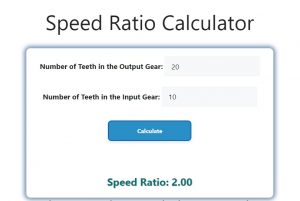About Speed Ratio Calculator (Formula)
The Speed Ratio Calculator is a crucial tool for engineers, mechanics, and hobbyists working with gear systems. Understanding the speed ratio helps determine how gears interact in machinery, affecting performance and efficiency. The speed ratio is the relationship between the number of teeth on the output gear and the input gear, allowing users to predict how the input speed will translate to output speed. This article explains the formula, how to use the calculator, and provides a comprehensive FAQ section to clarify common queries.
Formula
The formula for calculating the speed ratio is: Speed Ratio = Output Gear Teeth / Input Gear Teeth. In this formula, the output gear teeth represent the number of teeth on the gear being driven, while the input gear teeth refer to the number of teeth on the gear providing the input motion.
How to Use
Using the Speed Ratio Calculator is simple:
- Count the Teeth: Determine the number of teeth on both the output gear and the input gear.
- Input Values: Enter the number of teeth for the output gear and the input gear into the calculator.
- Calculate: Click the “Calculate” button to find the speed ratio.
- Interpret the Result: A higher speed ratio indicates that the output gear will turn slower than the input gear, while a lower ratio means the opposite.
Example
Let’s calculate the speed ratio for a gear system where the output gear has 20 teeth and the input gear has 10 teeth.
- Output Gear Teeth: 20
- Input Gear Teeth: 10
Using the formula:
Speed Ratio = Output Gear Teeth / Input Gear Teeth
Speed Ratio = 20 / 10
Speed Ratio = 2
In this example, the speed ratio is 2, meaning the output gear will rotate at half the speed of the input gear.

FAQs
- What is a speed ratio?
The speed ratio is a measure of how the rotational speed of an output gear compares to an input gear in a gear system. - Why is the speed ratio important?
It helps determine how power and motion are transferred in mechanical systems, affecting performance and efficiency. - What does a speed ratio greater than 1 indicate?
A speed ratio greater than 1 indicates that the output gear will rotate slower than the input gear. - What does a speed ratio less than 1 indicate?
A speed ratio less than 1 indicates that the output gear will rotate faster than the input gear. - Can I use this calculator for any gear type?
Yes, the speed ratio calculator can be used for various types of gears, including spur, bevel, and worm gears. - How does gear size affect the speed ratio?
The number of teeth on the gears directly impacts the speed ratio; more teeth on the output gear will lower the output speed. - What happens if the input gear has more teeth than the output gear?
If the input gear has more teeth, the speed ratio will be less than 1, meaning the output gear rotates faster. - Can I use this calculator for multiple gear systems?
Yes, the calculator can be used for any gear system, but each pair of input and output gears must be calculated separately. - How do I determine the number of teeth on a gear?
Count the teeth around the circumference of the gear or refer to manufacturer specifications. - What is the maximum speed ratio possible?
There is no theoretical maximum, but practical limits depend on the gear system design and application. - Does the calculator account for friction and efficiency losses?
No, the calculator provides a theoretical speed ratio without accounting for friction or mechanical losses. - How can I improve the efficiency of a gear system?
Use high-quality bearings, lubricants, and minimize friction between gears to enhance efficiency. - What materials are commonly used for gears?
Gears can be made from various materials, including steel, plastic, and aluminum, depending on the application. - Can speed ratios be used in non-mechanical systems?
While primarily used in mechanical contexts, similar principles can apply to other systems involving ratios of inputs and outputs. - How often should I check gear systems for wear?
Regular inspections are recommended, typically every few months, depending on the usage and environment. - What role does gear ratio play in vehicle performance?
In vehicles, gear ratios impact acceleration, top speed, and fuel efficiency. - How can I adjust the speed ratio in my gear system?
You can adjust the speed ratio by changing the number of teeth on either the input or output gears. - Are there software tools available for more complex gear calculations?
Yes, various engineering software tools can model complex gear systems and provide detailed analyses. - Is there a relationship between gear ratio and torque?
Yes, there is an inverse relationship; as speed increases, torque decreases, and vice versa, based on the gear ratio. - What should I do if my gears are making noise?
Noisy gears may indicate misalignment, wear, or lack of lubrication. It’s best to consult a mechanic or technician for diagnosis.
Conclusion
The Speed Ratio Calculator is an invaluable tool for anyone involved in mechanical design or maintenance. By understanding how to calculate and interpret speed ratios, users can optimize gear systems for better performance and efficiency. Whether in automotive, industrial, or hobbyist applications, knowing the speed ratio enhances decision-making and can lead to improved outcomes in machinery and equipment.